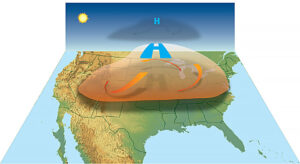The continued burning of fossil fuels is increasing the levels of carbon dioxide in the atmosphere. Accordingly, the oceans have been absorbing massive amounts of carbon dioxide. This increasing amount of carbon dioxide in the oceans has resulted in ocean acidification.
When carbon dioxide enters the ocean, it combines with seawater to form carbonic acid, which increases the acidity of the ocean, lowering its pH, which is a measure of acidity or alkalinity. A solution below 7 is acid, a solution above 7 is alkaline, or base.
Although it is unlikely the ocean will ever actually become acid, the term acidification refers to the process of oceans becoming more acidic.
Since the beginning of the Industrial Revolution, circa 1750, the pH of surface ocean waters has fallen by .1 pH units. Since the pH scale is logarithmic, this change represents a 30 percent in acidity. Models show that the oceans will continue to absorb carbon dioxide, further increasing ocean acidity. Estimates of future carbon dioxide levels, based on current output, indicate that by the end of this century, the surface waters of the ocean could have acidity nearly 150 times higher, resulting in a pH for the oceans that has not been seen for more than 20 million years.
Scientists formerly did not worry about his process because they assumed that rivers carry enough chemicals from rocks to the oceans to keep the ocean’s pH stable. However, so much carbon dioxide is dissolving into the ocean so quickly that this natural “buffering” has not been able to keep up.
This has resulted in the binding up of carbonate ions, which are used by marine creatures to make their calcium carbonate shells and skeletons. As the availability of carbonate ions decreases, it becomes more difficult for these animals to build their calcium carbonate structures. By the middle to end of this century, parts of the ocean will be corrosive enough that they will dissolve already formed calcium carbonate.
Even more significant is the rate at which ocean chemistry is changing. The current rate of acidification is at least 100 times faster than any time period over the last few hundred thousand years and is probably unprecedented in Earth’s history. Carbon dioxide is being absorbed so rapidly that many marine organisms will not be able to adapt to quickly changing conditions.
One of the major concerns is that most vulnerable species to ocean acidification are also some of the most important for healthy marine ecosystems. Ocean acidification may adversely impact some plankton species, and their losses would ripple through the food chain to impact larger animals like fish and whales.
Corals are also very susceptible to the impact of ocean acidification and coral reefs are some of the most beautiful and biologically diverse habitats on the planet. They also protect coastlines from the damaging effects of wave action and tropical storms.
Ocean acidification has the potential to cause widespread changes in the marine ecosystem which may eventually disrupt the ocean goods and services that we depend on. If nothing is done to help stem ocean acidification, it will negatively impact marine life, local communities, and even the global economy.










